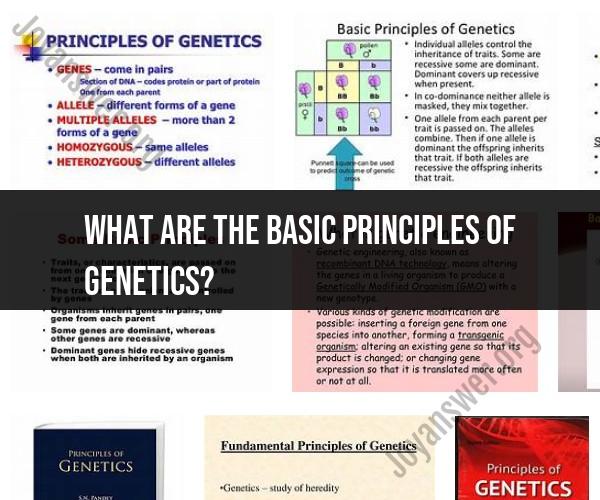What are the basic principles of genetics?
The basic principles of genetics lay the foundation for understanding how traits are inherited and passed from one generation to the next. These principles were established through the pioneering work of scientists like Gregor Mendel and subsequent research in the field of genetics. Here are the key basic principles of genetics:
Mendel's Laws of Inheritance:
- The Law of Segregation: This law states that an individual has two alleles for each gene, one inherited from each parent. During gamete formation (sperm and egg cells), these alleles segregate randomly so that each gamete carries only one allele for each gene.
- The Law of Independent Assortment: This law states that alleles of different genes assort independently during gamete formation. In other words, the inheritance of one gene does not affect the inheritance of another gene, leading to various combinations of alleles in offspring.
Dominance and Recessiveness:
- Genes can have dominant and recessive alleles. Dominant alleles determine the observable trait (phenotype) in a heterozygous individual (one with two different alleles). Recessive alleles are expressed only when an individual carries two copies of the recessive allele.
Genotype and Phenotype:
- An individual's genetic makeup is called their genotype, which consists of the specific alleles they carry for a particular gene. The observable physical or biochemical characteristics resulting from these alleles are called the phenotype.
Punnett Squares:
- Punnett squares are a visual tool used to predict the possible genotypes and phenotypes of offspring in a genetic cross. They are based on the principles of Mendelian genetics.
Homozygous and Heterozygous:
- Individuals with two identical alleles for a gene are homozygous (e.g., AA or aa), while those with two different alleles are heterozygous (e.g., Aa).
Incomplete Dominance:
- In some cases, neither allele in a heterozygous individual is completely dominant. Instead, they blend to produce an intermediate phenotype (e.g., red x white flowers producing pink flowers).
Codominance:
- Codominance occurs when both alleles in a heterozygous individual are fully expressed, resulting in a combined phenotype (e.g., blood type AB).
Multiple Alleles:
- Some genes have more than two alleles in a population. A classic example is the ABO blood group system, which has three alleles: A, B, and O.
Sex-Linked Inheritance:
- Some traits are located on the sex chromosomes (X and Y). X-linked traits are often expressed differently in males and females because males have only one X chromosome.
Pedigree Analysis:
- Pedigree charts are used to trace the inheritance of traits within families. They help identify patterns of inheritance, including autosomal dominant, autosomal recessive, and X-linked traits.
Genetic Disorders:
- Understanding genetics is crucial for studying and addressing genetic disorders caused by mutations in specific genes. This knowledge contributes to genetic counseling and medical treatments.
These principles provide a fundamental framework for understanding how genetic information is passed from parents to offspring and how traits are inherited. Modern genetics has expanded on these basics, uncovering the complexity of gene interactions, epigenetics, and the role of genes in various biological processes.











